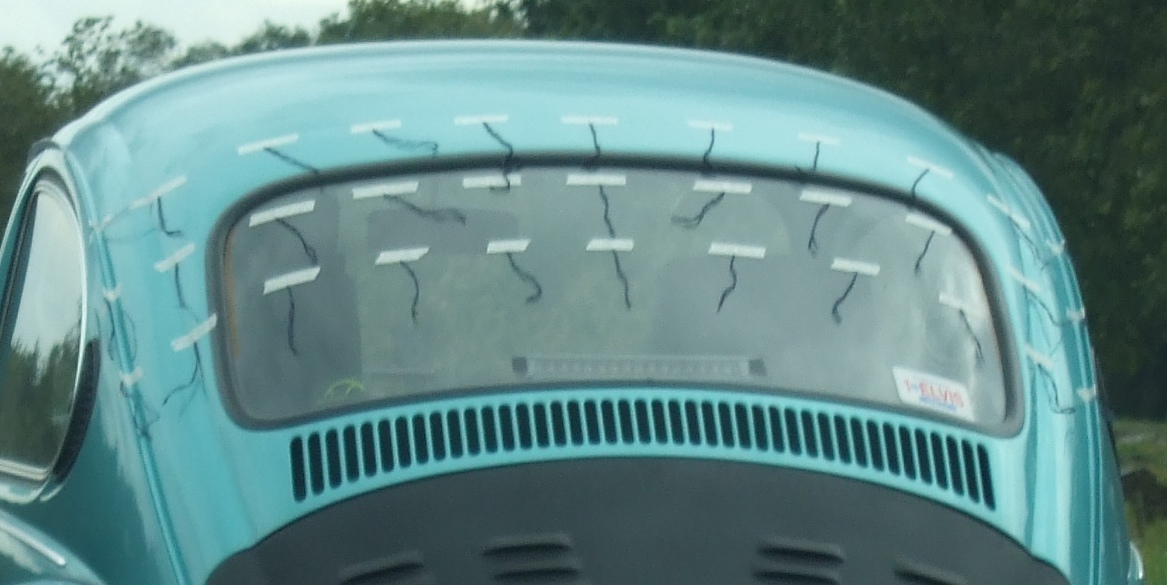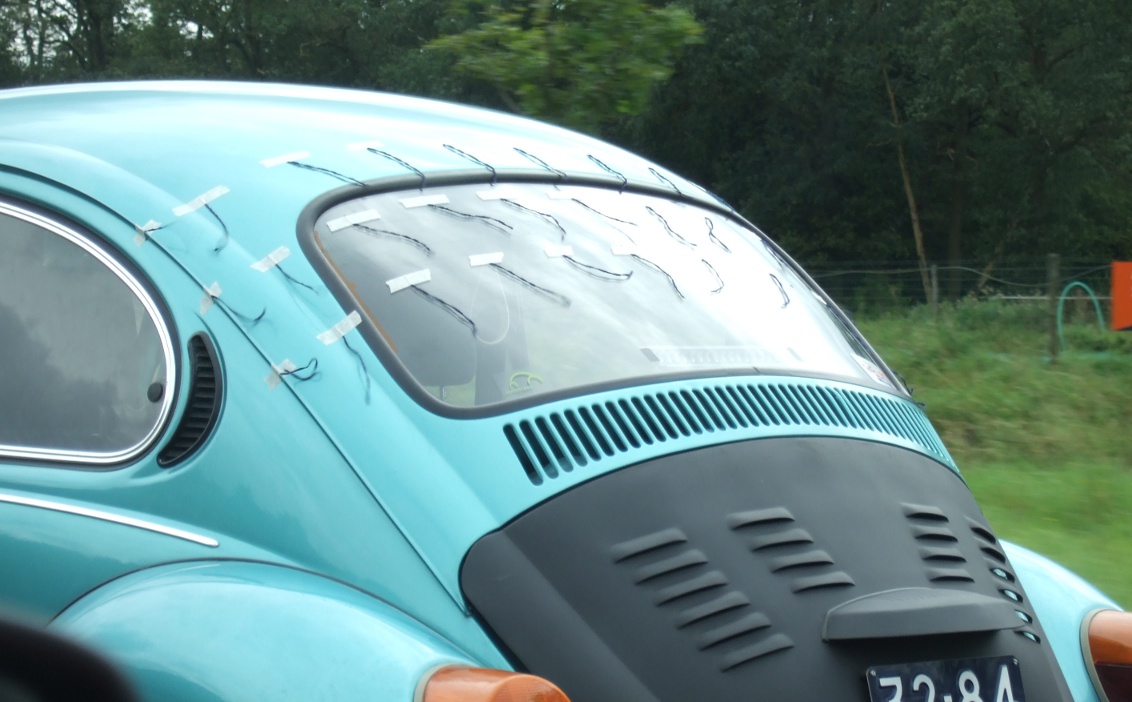Where the spoiler was, I added a row of tufts to replace the tufts that were on the spoiler. Then we went back on the highway.
At 100 km/h:
A close up picture:

As you can see the bottom tufts are now pointing down, flat on the rear window. The airflow stays attached at the window.
Because the angle of the rear window is too steep, this causes drag and a bit of lift.
From an angle:

Look at the top tufts, they follow the shape of the rear window rubber. They are pressed against it, forcing it to follow the shape.
I really like the way the results are the same as the ones from the Autospeed.com article!
The spoiler is definitely doing something!
I’m just wondering what people were thinking when they saw me driving on the highway like that… 

Good job!
This is something I know I’ve wanted to try and never made the effort 🙁
“The more I learn about (basic) aerodynamics the less I know”… So much to learn. So little time 🙂
No question -IMHO- that the airflow had detached at the point of your spoiler, as expected. The yarn looks like it’s doing a great job of visualizing (for us) the air flow. It’s really slick to see a low-tech-low-cost method of understanding the hidden air flow.
Thanks so much for taking the time to share! Really appreciate it.
R
Long Beach
Ca. USA
Thank you for the kind words, Randy! 😎
In the 1971 my family bought a Super Beetle wit AC. my mother & I picked it up at the Porsche plant in Stuttgart. I was 14 & we drove it around Europe for a while before bringing it home to Charleston, South Carolina (USA). One of the AERO tricks that we tried was a thin, sheet metal, matt black spoiler which mounted on thin, sheet metal stands on the body vent below the rear window. This made the car more stable when passing semi-trucks at about 130 KPH. The highway gas millage also increased 3-4%. This, being at the top of the rear window, seems like it would do even better.
Hi Eddie,
Very cool, that must have been quite an adventure driving through Germany in 1971. Germany has a lot of very beautiful areas.
Once a year we do a weekend holiday with our beetle in Germany (we live close to the German border). We really like Germany as a holiday destination.
The spoiler you are talking about sound like a “Herrod Helper”:
http://vwparts.aircooled.net/Herrod-Helper-Rear-Spoiler-Street-Wing-p/herrod-helper.htm
A lot of people have had the same experience as you with the Herrod Helper. Better gas millage and more stability.
Thanks for your comment!
Greetings,
Gerrelt.
Something that I wonder is being factored in here. remember that a New Beetle is a rebodied Vw Golf; a front engine watercooled car. The “old” Beetle is of course air cooled and relies heavily on air drawn in through the vents below the back window.
Surely, therefore, we want to direct air into this area rather than away from it (airflow separation). The suction from the vent area is going to reduce the boundary layer significantly anyhow I should think? In terms of rear airflow, the engine and it’s cooling fan are a major factor: Air goes in through the rear vent, through the engine, and is expelled at pressure through the rear beneath the apron and guards, reducing rear drag. This is an effect that wind tunnel tests of the Beetle rarely take into account because they are static tests with the engine switched off!
It would be interesting to play with spoiler shapes above and below the cooling vent to see what effect it has on overall airflow dynamics.
Hi Martin,
I think you over-estimate the amount of air the engine is sucking in. Compared to the fast amount of air passing over the car at, say, 80 km/h, it’s probably only a small percentage.
If it was comparable, you wouldn’t be able to stand behind a beetle without experiencing a storm-like wind coming from under the car.
Greetings,
Gerrelt.
It should also be noted that with the Convertible bugs, there were no vents below the rear window, only in the engine hood. I’ve also looked at wind-tunnel tests on the bug and there isn’t much directed flow below the rear window. For anybody that wants air-flow, the best place I think would be above or just to the upper sides of the rear window.
Um
if your trying to increase mpg the Tufts pointing up mean there’s more drag therefor decreasing mpg.
You want the air as close to car as long as possible on the rearend. That’s why the best aerodynamic shape is a teardrop type shape.
Hi Bob,
I disagree. The rear of the beetle is not like the teardrop shape, it’s too steep.
The ideal angle is at about 15 degrees, probably a bit like the rear end of a Toyota Prius. The VW beetle rear is much steeper.
If you keep the air attached to the car as long as possible to the rear end on a beetle, it increases drag.
See also this page:
http://the-contact-patch.com/book/road/c1416-aerodynamic-forces#figure-Angle
Greetings,
Gerrelt.
Hey there,
I really liek what you’re onto. I flirted with the subjet myself a few years back. My main unanswered question was and still is “Does a spoiler on the back window – or a bar type above it (as remelle) – has an incidence on the amount of air entering the engine compartment, therefore on the engine cooling?”
Martin Harris raised the problem above. I can give you an approach of what I got into with my own road testing back then.
On a 1971 1302, a little lower than origin, stiff suspension, shorter white springs, shortened struts and bislstein all the way. Car had 5 speed gearbox and a 1745cc with a 36DRLA. Car was in the 5.5-6.5 L/100km with 185 on front and 205 in the back.
With the front vents slightly opened, Windows roll down by 1 to 2 cm, with chromed rain shields above window fresh air in the car, increased consumption, no heat change on the engine. Freeway test, between 90-130 km/h.
Vents half to fully opened, same speeds, got 20 to 30 °C up.
Solve that issue with a front (unfanned) oil cooler Under a vented appron. Reduced the increase of temp to 10-20 degrees.
Closed vents and Windows, opened rear popouts, 10 to 20°C increase in temp. Done after ram air front cooler installed. This preventing me from putting a front spoiler BTW.
No change in temp with a metal sun roof such as yours on the 1303.
Never got to do the tests for the rear spoilers. But I do think there is a reason why there are no above wings on 911 for a reason.
Some 993 have a 3rd brake light in a kinda spoiler just above the deck lid though. But I think it’s mainly for California 3rd break ligth régulations.
Hi,
You did some thorough testing!
So, what you are saying is a disturbance in airflow from the side of the beetle had a greater effect then a disturbance on the roof of the beetle? Interesting..
Might be something to do with the way the air curves inwards from the sides at the back of the car after it passes the sides.
Two things to remember though:
1. There is no airflow “into” the engine compartment in the stock configuration. The fan’s job is to suck air into the engine compartment.
There is a low pressure area behind the beetle that starts just above the rear vents. See this image:
http://images.gerrelt.nl/roofspoiler/beetle_windtunnel_test.jpg
2. Don’t compare the 911 with the beetle too much in this case. The rear of the 911 has a rear sloping back that more closely resembles the raindrop shape, which is the ideal aerodynamically shape.
That’s probably the reason why you don’t see the above wings on a 911.
The rear of the beetle is too steep, that’s why it can benefit from a roofspoiler.
See also this page:
http://www.gerrelt.nl/section-aerodynamics/aerodynamics-roofspoiler-explanation
Greetings,
Gerrelt.
Thing to remember about the Autospeed article and the author is that the analysis of the results is limited in its depth, in part as the author has no formal education in aerodynamics and is not noted for details. Attached flow is good for some aspects as he notes, but he does not go into the effects on stability. Detaching the flow at the rear with the soiler as you have done is a good idea on a car with the Beetle shape.
I think Julian Edgar is in-depth enough. He makes his articles really readable and understandable for everybody.
He is a self-taught man, and wrote several books, including two on aerodynamics:
https://www.amazon.com/s?k=Julian+Edgar&ref=nb_sb_noss_2
This thread, even though (in 2022, somewhat old) is fascinating and has useful considerations for subsequent inquiries about aft VW Beetle aerodynamics, particularly with regard to cooling effects between airflow aerodynamics and the louvered vents that later VW Beetles all had to supposedly help entrain engine compartment cooling air.
Here is a current thread dealing with what I call the ‘Coanda Cowl’ device on THE SAMBA FORUM (DATED 2022): https://www.thesamba.com/vw/forum/viewtopic.php?p=9918338#9918338